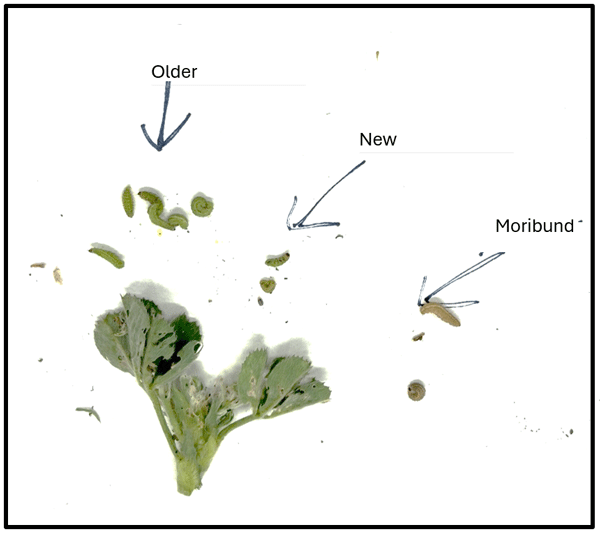It doesn’t seem like spring can decide to stay here for good. We experienced a wide range of temperatures in March, from +70°F to 15°F. Alfalfa weevil egg development threshold is above 48°F. This wide range of temperatures has placed the alfalfa weevil hatch over a relatively long period. If the alfalfa weevil larvae are in the terminal of the alfalfa plant, they often freeze below 25°F and become moribund. But sometimes, they crawl under the leaf litter and survive a freeze. Each field is different, and whether to treat or not requires scouting in each field.
Treatment is all about timing. Right now, much of the alfalfa is short, and treating too early may lead to part of the plant being untreated as the plant grows. Many different instars of alfalfa weevil larvae are present due to this fluctuation of temperatures this spring. Some of the larvae look brown and are moribund due to the freeze (see Fig. 1 right side), some have just hatched and are smaller larvae since the last freeze (you will find these most likely in the terminal part of the plant (see Fig. 1 middle larvae)), and some are bigger and hatched a few weeks ago, but may have sheltered in the leaf litter (see Fig 1. larvae on the left). The larger larvae 2-3 instars cause the most plant damage.

Figure 1. Different stages of alfalfa weevil larvae. Image from K-State Extension Entomology.
Alfalfa weevil larvae cause damage to the plant, as depicted above, and can be present through April. If it is late in the season, the best way to manage alfalfa is to just swath the field if possible.
Amie Norton, Entomology Post-Doc Fellow
amien@ksu.edu
Jeff Whitworth, Extension Entomologist
jwhitwor@ksu.edu
Tags: insects alfalfa alfalfa weevils